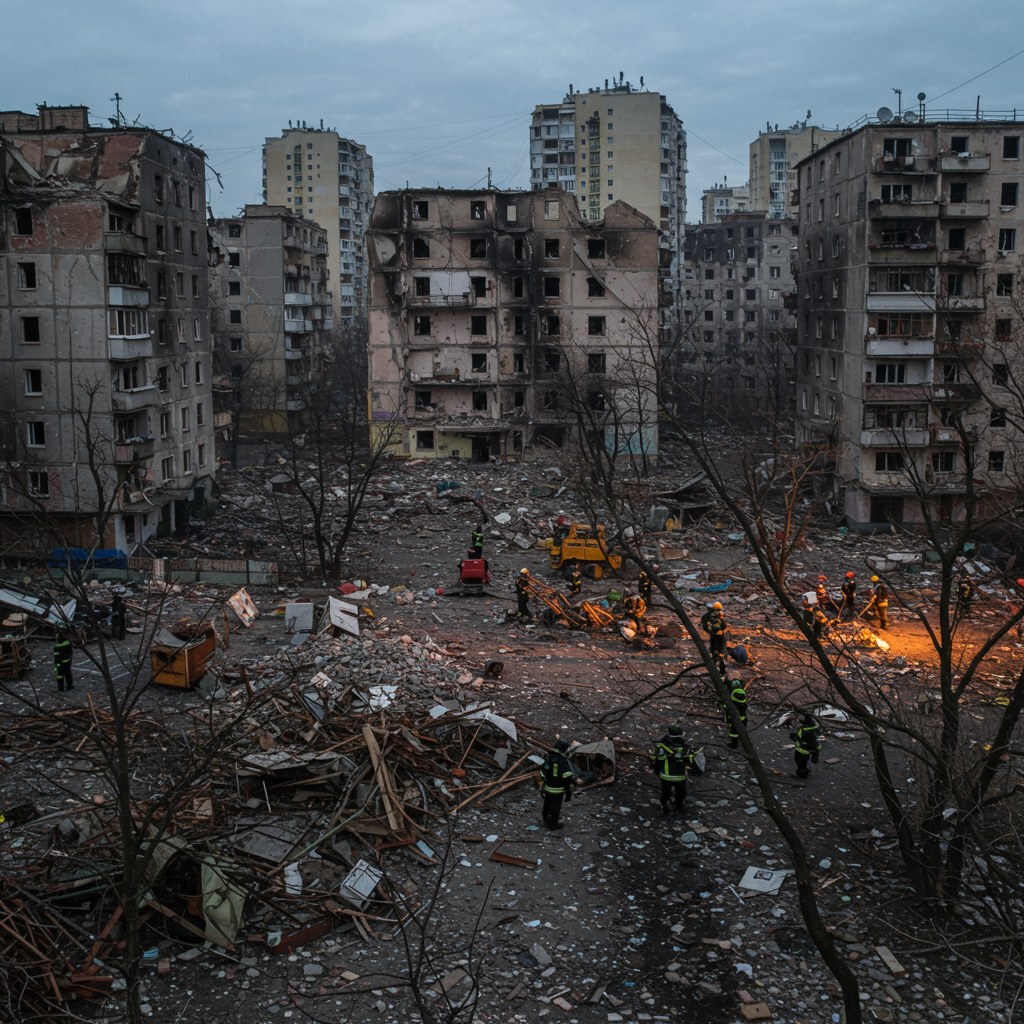Kyiv, Ukraine was hit by one of the most devastating Russian attacks in nearly a year overnight into Tuesday, as a massive barrage of drones and missiles struck the capital, killing at least 14 people and injuring scores more. The assault, which lasted for nearly nine hours, caused extensive damage, particularly to residential buildings, highlighting the ongoing threat faced by civilians.
Ukrainian officials reported that Russia launched over 440 drones and 32 missiles across the country during the night, with Kyiv bearing the brunt of the assault. While Ukraine’s air defense forces successfully intercepted a large number of these munitions – reportedly shooting down over 400 drones and 26 missiles – many still found their targets, including critical civilian infrastructure.
Devastation Strikes Residential Building
A nine-story apartment building in Kyiv’s Solomianskyi district suffered a direct hit from a ballistic missile, with one entire entrance collapsing and causing damage from the upper floors down to the basement. The strike split the building in two, leaving a gaping hole where dozens of apartments once stood.
Residents recounted terrifying moments as the attack unfolded. Victoria, who sheltered in her bathroom before an explosion blew out her windows, described the sheer terror. “It was very scary. Adrenaline was pumping. Just survival instincts,” she told CNN. She initially thought the attack was over but was woken by the blast, realizing her building had been hit only after neighbors helped clear debris blocking her door. “I thought I was ready to die and wasn’t afraid of anything. But today I realized that I’m scared. For the first time, I was scared,” said Victoria, who had already fled her home in eastern Ukraine years ago.
Oleksandr Ustenko, another resident of the same building, described hearing drones overhead throughout the night before a missile struck. “Everything started shaking, the ceiling shook, and the door was blown out,” he said. As he and his family fled into the hallway, everything around them was on fire. “We barely made it to the street,” he added. “The apartment is almost destroyed, our car is destroyed.”
Rescue operations continued throughout Tuesday, with over 2,000 emergency responders searching through the rubble for survivors and casualties. Officials confirmed that five bodies were pulled from the damaged building by midday.
Rising Death Toll and Widespread Damage
Across Kyiv, 27 different locations in various districts were impacted by the strikes, resulting in damage to nearly 150 residential buildings. Fires broke out in several areas due to falling debris from intercepted drones.
According to local authorities and verified by the UN Human Rights Monitoring Mission in Ukraine (HRMMU), the attack killed at least 14 civilians in Kyiv and injured 139 others. One of the fatalities in the capital was a 62-year-old U.S. citizen who died from shrapnel wounds. The U.S. State Department later confirmed the death and condemned the strikes. Beyond Kyiv, the attack also resulted in at least one death and 17 injuries in the southern port city of Odesa. In total, Ukrainian officials reported 15 people killed and over 150 injured nationwide.
The UN HRMMU stated that this attack was likely the deadliest on Kyiv since July 2024. They highlighted that the tactic of using simultaneous missiles and a large number of drones in populated areas poses a “serious threat” to civilians. Ukrainian Minister of Internal Affairs Ihor Klymenko noted that the enemy delivered “direct hits on residential buildings,” contradicting Russian claims of targeting only military infrastructure. Residents echoed this, with one saying there was “no military infrastructure here, nothing.”
Kyiv Mayor Vitalii Klitschko declared Wednesday an official day of mourning for the victims.
Context and International Reactions
The intensified aerial bombardment comes as the conflict enters its fourth year and follows recent failed peace talks. Russia has significantly ramped up its long-range strikes in recent months, including launching nearly 500 drones in a single night in June, described as the largest such attack of the war. This escalation coincides with a Russian summer offensive along the eastern and northeastern front lines, where Ukraine is seeking increased military support from Western partners. The UN notes that civilian casualties in the first five months of this year are almost 50% higher compared to the same period in 2023.
The timing of the massive attack also coincided with Ukrainian President Volodymyr Zelenskyy’s attendance as a guest at the G7 summit in Canada, where he was expected to press for more aid. Ukrainian Foreign Minister Andrii Sybiha called the attacks during the G7 a signal of Russian President Vladimir Putin’s “total disrespect” for international diplomacy and urged for stronger international action. President Zelenskyy himself characterized the attack as “pure terrorism” and criticized global powers for potentially “turning a blind eye.”
Uncertainty regarding future U.S. aid for Ukraine has been a key concern. President Zelenskyy’s planned meeting with U.S. President Donald Trump at the G7 summit was canceled after Trump returned early to Washington, citing rising tensions in the Middle East.
Meanwhile, Russian Security Council Secretary Sergey Shoigu arrived in Pyongyang on a “special mission” from Putin, reportedly to meet with North Korean leader Kim Jong Un. North Korea has been a significant supplier of munitions to Russia, sending millions of shells and rockets, according to international monitoring groups. The U.S. has previously warned that Russia might exchange advanced military technology, potentially including space and satellite capabilities, for this continued support.

